Symmetric Matrix in Discrete mathematicsIn case of discrete mathematics, we can define a symmetric matrix as a square matrix that is similar to its transpose matrix. We can call a matrix as square matrix if it contains the same number of rows and columns. If there is a matrix A, then the transpose of this matrix will be indicated by the symbol AT. If a matrix satisfies the condition A = AT, then that matrix will be a symmetric matrix. We have several types of matrices, but the most important type of matrix, which is mostly used is the symmetric matrix. In this section, we are going to learn about the symmetric matrix, its properties, theorems of a symmetric matrix, the difference between a symmetric matrix and a skew-symmetric matrix, examples of a symmetric matrix and many more. What is symmetric matrixIf there is a square matrix, then we can call it a symmetric matrix if we calculate the transpose of this matrix and it remains unchanged. That means in case of a symmetric matrix, the original matrix and its transpose matrix will be the same. Definition of symmetric matrixSuppose there is a square matrix B which contains the size n∗n. This matrix will be considered as symmetric iff BT = B. If this given square matrix B and the transpose of this matrix are similar to each other, then we can call this matrix as the symmetric matrix. The symmetric matrix can be represented in the following way: If there is a symmetric matrix B = [bij]n∗n, then bij = bji for all i and j or 1 ≤ i ≤ n. Here
Transpose of a matrixA matrix will be known as the transpose matrix if we interchange the elements of rows or columns of the original matrix. We can indicate the transpose of a matrix with the help of symbol T. If there is a matrix which is indicated by n∗m, then its transpose matrix will be indicated by m∗n. Now we will understand the concept of transpose by an example, which is described as follows: Example 1: Suppose we have a 2∗2 matrix A. Here we have to determine the transpose of matrix A. The elements of matrix A are described as follows: 
Solution: For the transpose matrix, we will change the first row into the first column, and the second row will be changed into the second column in the following way: 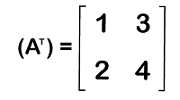
Here A ≠ AT. So this matrix is not a symmetric matrix. Example 2: In this example, we have a 3∗3 matrix A. We have to determine the transpose of matrix A. The elements of matrix A are described as follows: 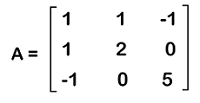
Solution: To perform the transpose of this matrix, we will change the first row into the first column and the second row will be changed into the second column, and the third row will be changed into the third column in the following way: 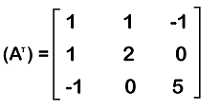
Here A = AT. Hence it is a symmetric matrix. Steps to determine the symmetric matrixThere are some steps which we should be followed to determine whether the matrix is symmetric matrix or not. These steps are described as follows: Step 1: In this step, we will determine the transpose of a matrix. Step 2: In this step, we will check whether the original matrix and the transpose of this matrix are similar to each other or not. Step 3: The matrix will be known as the symmetric matrix if the original matrix and the transpose matrix are similar to each other. Now we will understand this concept with the help of an example, which is described as follows: Suppose we have a matrix A where 
The transpose of this matrix is described as follows: 
The original matrix A and its transpose matrix AT are similar to each other. Hence A is a symmetric matrix. Symmetric matrix ExamplesNow we will understand the symmetric matrix with the help of an example. Suppose we have a 3∗3 square matrix, B where 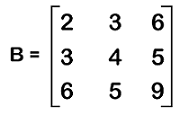
The transpose of matrix B is described as follows: 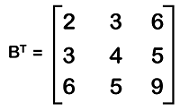
In this example, we have BT = B. For example, b12 = b21 = 3 and b13 = b31 = 6. Thus, we can say that B is a symmetric matrix. Now we will show some more examples of symmetric matrices, but with different orders. Example 1: In this example, we will show a symmetric matrix with an order 2∗2, i.e., 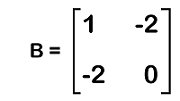
In this matrix, we can see that we have a square matrix that contains 4 elements. These elements are arranged in the form of 2 rows and 2 columns. Example 2: In this example, we will show a symmetric matrix with an order 3∗3, i.e., 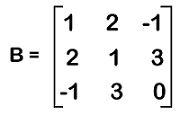
In this matrix, we can see that we have a square matrix that contains 9 elements. These elements are arranged in the form of 3 rows and 3 columns. Example 3: In this example, we will show a symmetric matrix with an order 4∗4, i.e., 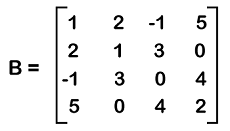
In this matrix, we can see that we have a square matrix that contains 16 elements. These elements are arranged in the form of 4 rows and 4 columns. Properties of Symmetric matrixThere are various properties of a symmetric matrix, and some of them are described as follows:
Theorems of Symmetric matrixIn case of a symmetric matrix, we have two important theorems. Here we will learn about both the theorems as well as their proofs. Theorem 1: If there is a square matrix B, which contains the real number elements, in this case, B + BT will be a symmetric matrix and B - BT will be a skew-symmetric matrix. Proof: Here we will assume that A = B + BT Now we will take the transpose of assumed matrix A and get the following: AT = (B + BT)T= BT+ (BT)T= BT+ B = B + BT= A This shows that B + BT is a symmetric matrix. After that, we will assume that C = B - BT Now we will take the transpose of assumed matrix C and get the following: CT = (B + (-BT))T= BT+ (- BT)T= BT- (BT)T= BT - B = -(B - BT) = -C This shows that B - BT is a skew-symmetric matrix. Theorem 2: If there is a square matrix, then we can write this matrix as the addition of a symmetric matrix and skew-symmetric matrix. With the help of following formula, we can determine the addition of a skew-symmetric matrix and a symmetric matrix. Suppose there is a square matrix B. Then, B = (1/2) × (B + BT) + (1/2) × (B - BT). Here transpose of matrix B is shown with the help of symbol BT.
Hence if there is a square matrix, then we can write this matrix as the addition of a skew-symmetric matrix and symmetric matrix. Example: In this example, we have a matrix B, and we have to express it in the form of addition of a symmetric matrix and skew-symmetric matrix. The elements of matrix B are described as follows: 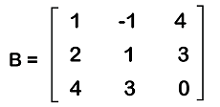
Solution: As we have learned that we can write this matrix as the addition of a skew-symmetric matrix and a symmetric matrix. So we can also express matrix B in the following way: B = (1/2) × (B + BT) + (1/2) × (B - BT) Here (1/2) × (B + BT) is used to indicate the symmetric matrix (1/2) × (B - BT) is used to indicate the skew-symmetric matrix 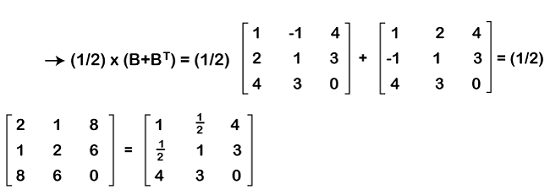
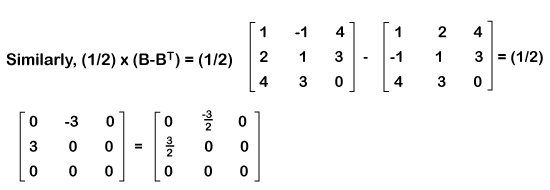
In the following way, we can calculate the addition of a symmetric matrix and skew-symmetric matrix: 
Here 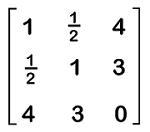
is used to indicate the symmetric matrix and 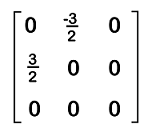
is used to indicate the skew-symmetric matrix. Difference between Symmetric matrix and Skew symmetric matrixThere is a close relation between the symmetric and skew-symmetric matrices. We can show one major difference between the symmetric matrix and the skew-symmetric matrix. This difference is described as follows:
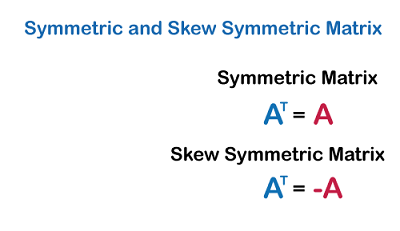
Important Points on Symmetric matrixThere are some important points which we should know while learning the concept of a non-singular matrix. These points are described as follows:
Examples of Symmetric matrixThere are a lot of examples of a symmetric matrix, and some of them are described as follows: Example 1: In this example, we have two matrices, and we have to determine which matrix is a symmetric matrix. 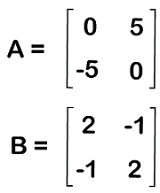
Solution: Here, we will first check whether matrix A is a symmetric matrix or not 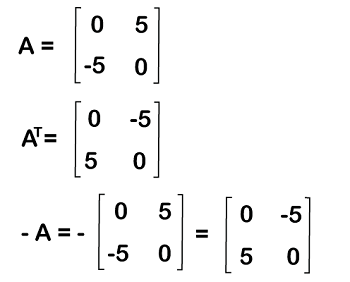
Here we have AT = -A. Hence, matrix A is not a symmetric matrix. This property satisfies the condition of a skew-symmetric matrix. Hence this matrix is not a symmetric matrix, but it is a skew-symmetric matrix. Now we will check the second matrix B in the following way: 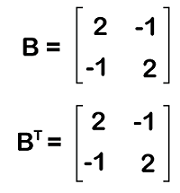
Here we have BT = B. Hence matrix B is a symmetric matrix. Answer: Matrix A is a skew-symmetric matrix, and matrix B is a symmetric matrix. Example 2: In this example, we have two matrices, and we have to determine whether the given matrices are symmetric matrices or not. 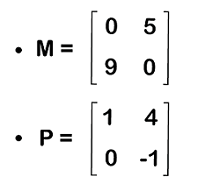
Solution: Here, we will first check whether matrix M is a symmetric matrix or not. So for this, we will do the transpose of matrix M and get the following: 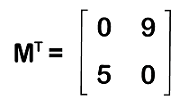
Here we can see that the matrix M and its transpose matrix MT are not similar to each other. Hence matrix M is not a symmetric matrix. Now we will check whether matrix P is a symmetric matrix. So we will again check the transpose of matrix P like this: 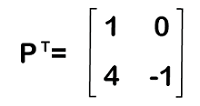
Here we can see that the matrix P and its transpose matrix PT are not similar to each other. Hence matrix P is not a symmetric matrix. Answer: Matrix M and matrix P both are not symmetric matrix. Example 3: In this example, we have a matrix A, and the elements of matrix A are described as follows: 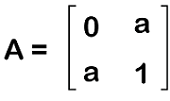
Here we have to determine which option is correct for matrix A.
Solution: The matrix A and its transpose are described as follows: 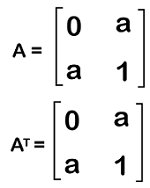
Here we can see that matrix A and its transpose matrix AT are similar to each other. Hence matrix A is a symmetric matrix. Answer: The correct option is (a). Example 4: In this example, we have a symmetric matrix A, where 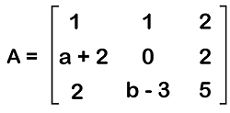
Now we have to determine the values of a and b. Solution: From the question, we know that A is a symmetric matrix. So AT = A. 
Now we will compare the corresponding elements in the following way: a + 2 = 1 ⇒ a = -1 b - 3 = 2 ⇒ b = 5 Answer: The value of a is -1, and the value of b is 5. |
 For Videos Join Our Youtube Channel: Join Now
For Videos Join Our Youtube Channel: Join Now
Feedback
- Send your Feedback to [email protected]
Help Others, Please Share










